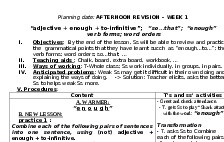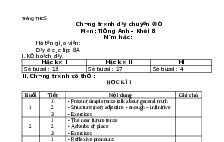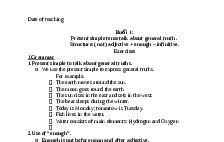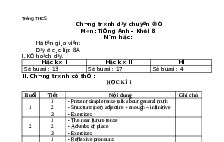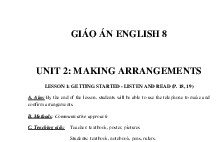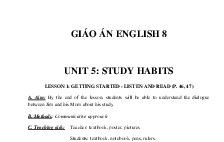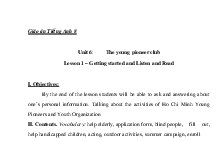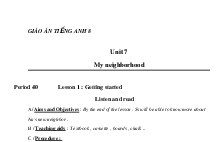Giáo án Tiếng Anh 8 Unit 3: At home
Nội dung tài liệu
Tải xuống
Link tài liệu:
Các tài liệu liên quan
-
![GIÁO ÁN DẠY THÊM TA 8.]()
-
![Giáo án chuyên đề Anh 8 mới]()
-
![Giáo án dạy thêm Anh 8 mới]()
-
![Giáo án chuyên đề Anh 8 mới]()
-
![Giáo án Tiếng Anh 8 Unit 2: Making arrangements]()
-
![Giáo án Tiếng Anh 8 Unit 3: At home]()
-
![Giáo án Tiếng Anh 8 Unit 4: Our past]()
-
![Giáo án Tiếng Anh 8 Unit 5: Study habits]()
-
![Giáo án Tiếng Anh 8 Unit 6: The young pioneers club]()
-
![Giáo án Tiếng Anh 8 Unit 7: My neighborhood]()
Có thể bạn quan tâm
Thông tin tài liệu
GIÁO ÁN ENGLISH 8UNIT 3: AT HOME LESSON 1: GETTING STARTED LISTEN AND READ (P. 27, 28)A. Aim: By the end of the lesson, students will be able to understand the dialoguebetween Nam and his mother and use modal verbs to talk about the housework.B. Methods Communicative approachC. Teaching aids: Teacher: textbook, poster, picturesStudents: textbook, notebook, pens, rulers.D. Procedure: I. Class organization: minuteII. Revision: (5 minutes) WARMUPIII. New lesson: 1. Setting the scene: Included in the WARMUP2. Main activities:Teacher’s and students’ activities On the board shows pictures (in Getting started) tostudents. asks them to look at pictures quicklyin 30 seconds and try to remember the WARM UPKim's game Expected answers: a. Wash dishes/ do the washing upb. Make the bedDoc24.vnverbs in the pictures as many as possible. Then each team goes to the board oneby one and writes down the activities inthe pictures. The team remembering moreverbs is the winner. models times then asks Ss to repeatchorally and individually. sets the scene: “Nam’s mother Mrs.Vui is busy and she wants Nam to dothree things for her.” gets Ss to listen to the dialogue whilelooking at their books and complete the listof the things Nam has to do. elicits the form by making questions. Ss copy down c. Sweep the floord. Cooke. Tidy upPRESENTATIONI Vocabulary rice cooker (picture) steamer: (picture) cup board: (picture) saucepan: (picture) frying pan (picture)* Checking What and WhereII. What Nam has to do? Nam has to cook dinner go to the market to buy fish andvegetables call his aunt, Ms Chi and ask her tomeet his mother at grandma's houseForm: Has have to infinitive Must +infinitiveMeaning Ph (làm gì)ảDoc24.vn models two cues then asks Ss to repeatchorally then individually. asks Ss to practice asking andanswering in pairs (open pairs closedpairs) Ss work in groups of four, discuss thetopic, then representative from each groupstates their work. Use: express obligation or necessity+ Must: authority comes from speaker+ Have to: authority comes from outsidespeaker or lawsExchange: What do you have to do? must do the washing upPRACTICEPicture cued drill1. do the washing up2. make the bed3. sweep the floor4. cook dinner5. tidy my room6. feed the chickensFURTHER PRACTICEGroup discussion Talk about what we have to do and whatwe mustn’t do in class: Write in fullsentencesExpected answers :Have to: keep silent, do homework, learnlast lessons, raise opinion,...Mustn’t: make noise, be late, fall sleep,wear jeans ...Doc24.vnIV. Consolidation: (2 minutes) asks students to state the form and use of must and have to V. Homework Write the things you have to do on Sundays.Ex: On Sundays, have to tidy my rooms, .... have to help my parents do thehouse work, .... Do exercise 2 Prepare SPEAKDoc24.vnUNIT 3: AT HOMELESSON 2: SPEAK 2 (P. 28, 29)A. Aim: By the end of the lesson, students will be able to use the prepositions of place totalk about the positions of furniture in the house.B. Methods Communicative approachC. Teaching aids: Teacher: textbook, poster, picturesStudents: textbook, notebook, pens, rulers.D. Procedure: I. Class organization: minuteII. Revision: (5 minutes) WARMUPIII. New lesson: 1. Setting the scene: Included in the WARMUP2. Main activities:Teacher’s and students’ activities On the board divides the class into teams (House& Home) asks both teams one by one to goto the board and write down as manythings in the kitchen as possible within 3minutes. The team which has more correct wordswill win the game. WARM UPGame: What are there in the kitchen?Expected answers: Stove, sink, bowl, knife, lighting fixture,refrigerator, table, chair, pan, saucepan,chopstick, cup, glass, plate, spoon, ...PRESENTATIONI. Vocabulary:Doc24.vn elicits words from Ss and models 3times. shows the picture on page 28 and asksSs the positions of the items in the picture: gets Ss to work in pairs, talking aboutthe position of each item. rug (picture) lighting fixture (picture) coffee table (picture) counter (picture) calendar (picture) dish rack (picture)* Checking Slap the boardII. Questions :a. Where is the clock?b. Where is the fruit?c. Where are the flowers? d. Where is the rice cooker?e. Where is the cupboard?f. Where are the knives?g. Where is the dish rack? Expected answers: a. It's above the fridge.b. in the bowlc. on the table d. next to the bowl of fruite. on the wall, above the counter.f. they are on the wall, under the cupboard.g. on the counter, next to the bowl of fruit.Doc24.vn sets the scene: "Mrs. Vui bought somenew furniture for her living room, but shecannot decide where to put it. Please helpher to arrange the furniture" asks Ss to look at the picture on page29 and talk about their ideas. asks Ss to practice speaking using theexpressions. Ss work in pairs, try to use expressionsto make meaning and logical dialogue. calls some pairs to demonstrate. PRACTICEEx: The calendar is on the wall, above thestove. The knives are on the wall, under thecupboard.FURTHER PRACTICE USEFUL EXPRESSIONS:Agreeing DisagreeingOK.You're right No, think we'dbetter ought toput ...I think it shouldbe ... Expected answers Let's put the clock on the wall, betweenthe shelf and the picture.+ OK. think we ought to put the TV andthe stereo on the shelf.+ think the coffee table should be betweenthe couch and the armchair.+ Let's put the telephone next to the couch.+ think we should put the magazine abovethe books on the shelves. Doc24.vn+ think the shelves ought to be at one ofthe corners, opposite the couch.IV. Consolidation: (2 minutes) asks students to state the main expressions in talking about the positions of things. V. Homework Prepare the next part of the lesson: Listen and Language Focus 3Doc24.vnUNIT 3: AT HOMELESSON 3: LISTEN LANGUAGE FOCUS (P. 30, 35, 36)A. Aim: By the end of the lesson, students will be able to identify the right item bylistening and use reflexive pronouns. B. Methods Communicative approachC. Teaching aids: Teacher: textbook, poster, picturesStudents: textbook, notebook, pens, rulers.D. Procedure: I. Class organization: minuteII. Revision: (5 minutes) WARMUPIII. New lesson: 1. Setting the scene: Included in the WARMUP2. Main activities:Teacher’s and students’ activities On the board divides Ss into groups and askseach group to write down the food weeat. Ss write down and checks elicits each word and modelsthrice. WARM UPWho are quicker?Expected answer: meat, chicken, soup, garlic,onion, rice, noodles, cabbages, green pepper,etc.PRELISTENING1. Vocabulary: green pepper (n) (picture) ham (n) (realia)Doc24.vn Ss copy down gets Ss to look at P. 30 and guess 4things they use to cook the "SpecialChinese Fried Rice" has Ss listen to the tape twice orthrice and checks their prediction. sets the scene: “You do yourhomework and no one helps you. Whatdo you say?' garlic (n) (realia) repairman (explanation person whose jobis to repair things) (to) try (translation) (to) kill (explanation to makesomebody/something die)* Checking: what and where2. Prediction:a.b.c.d.WHILE LISTENING Expected answers: a. fried rice, b. pan, c. garlic and green peppers,d. ham and peas.PRESENTATIONREFLEXIVE PRONOUNS Form:I with myselfYou yourself yourselvesShe herselfHe himselfWe ourselvesDoc24.vn


